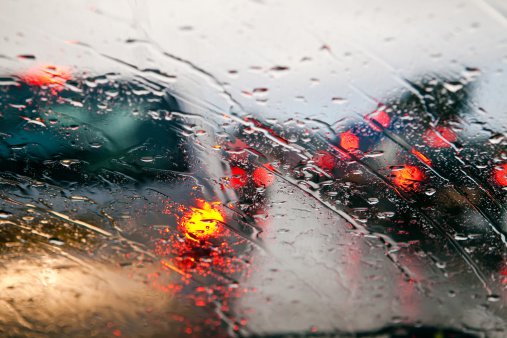
Driving in bad weather. If it is raining, icy, snowing or foggy, conditions on the road will be more dangerous. You need to drive with extra care….
Check your car
Effective brakes, tyres, windscreen wipers, lights and steering are even more crucial in wet weather. Check your vehicle regularly to make sure they are all in good condition.
Adjust your driving
Wet, frosty or icy roads can be very slippery. You need to increase your following distance because it takes longer to stop on a slippery surface. You should increase your following distance by using the four-second rule. Roads are extra slippery just after the rain commences and will remain so until the rain has washed any oil off the road.
Watch your visibility
Visibility (how far you can see) can be seriously reduced by rain, snow or fog. This can increase the risk of a crash. To improve visibility, keep all windows and mirrors clean. Don’t let windows fog up – turn on the demister or open a window.
Brake carefully
Unless your vehicle has ABS brakes, don’t brake too hard when it is wet. You may go into a dangerous skid. Instead, pump the brakes gently.
If your vehicle has ABS brakes, never pump the brakes in an emergency. Keep the pedal pressed down hard and steer out of trouble. Don’t become over-confident in driving because your vehicle has ABS brakes.
Spray
Be aware of approaching vehicles (huge trucks), as these can spray water on your windscreen as they pass. Even if it has stopped raining, if the road is still wet, you may need to turn on your windscreen wipers as the truck approaches.
Reduce speed
Driving at the speed limit on a wet road could be too fast for the conditions. You can lose control quickly in the wet, especially if you brake suddenly, so slow down.
Dip your headlamps in fog
If you drive with your lamps on full beam in fog, the light will reflect back on you. Dip your lights – it will be much easier to see.
Don’t just turn your park lights on. They are hard for oncoming drivers to see and do little to improve your vision.
You can use front fog lights when driving in fog. These have a wide, low beam and produce either a white or yellow light.
Rear fog lights, which produce a high-intensity red light, should only be used when visibility is terrible. (In normal conditions, they can dazzle drivers following you.)
Fog lights should be switched off as driving conditions improve.

Kelvin Armstrong Auto Repairs (KAAR) is recognised as the most competent, capable, and reliable automotive repairer west of the Auckland City isthmus.
With fully equipped, state of art facilities in both Avondale and Henderson, KAAR gives a choice of two handy locations for full automotive, mechanical, electrical repairs and servicing for all vehicles, including European makes and models like Audi, VW and BMW.
We cater for all makes and models of cars, vans, 4x4s and light trucks. We service petrol, diesel and hybrid motors.
